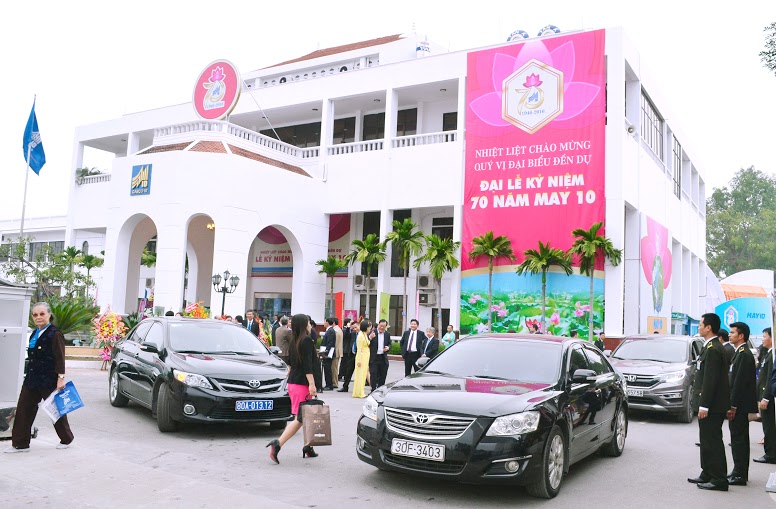
Linh Dang
Jim Rhodes –
Income inequality, raising the minimum wage, an unfair tax structure, gender based wages, corporate outsourcing to avoid taxes and adequately compensating workers has provided Bernie Sanders with issues that resonate with the working poor, students, veterans, and a cross section of Americans excluded by the corporate elite that now control Washington.
Mainstream Democrats and all Republicans scratch their heads at the alleged complexity of this manufactured problem.
Actually the solution is in plain sight. But we cannot continue with capitalism as usual.
Take the case of Vietnam, for example. Over the past dozen years the Vietnamese have entered into a variety of trade agreements and partnerships: the Association of South East Asian Nations Free Trade Area, first known as AFTA and now AEC or the ASEAN Economic Community which does not tax goods manufactured in Brunei, Malaysia, Myanmar, Indonesia, the Philippines, Cambodia, Thailand, Singapore, Laos, and Vietnam; the ASEAN-China Free Trade Area, the world’s largest trade area affecting more than 2 billion people; the Vietnam-Japan Economic Partnership Agreement; and the Vietnam-South Korea Complete Free Trade Agreement, which estimates bilateral trade between these nations to exceed $70 billion by 2020.
The most recent compact was signed last month between the European Union and Vietnam, the European Union Free Trade Agreement (EUFTA) making Vietnam the EUs second largest trading partner behind China.
According to Vietnam Economic Times, the European Union agreement will almost immediately positively affect the Vietnamese garment industry by an estimated $600 million and positively affect the Vietnamese footware industry by an estimated $500 million.
Last year in Vietnam there were 94,754 new enterprises generating an influx of capital at $26.69 billion, about a 27 percent increase over the previous year. The engine that pulls this train is the garment and textile industry. This is the primary reason the National Assembly has projected a 6.7 GDP for the coming year.
A watershed mark came in 2001 with the United States-Vietnam Bilateral Trade Agreement which opened Vietnamese textile markets to American investors. In 2002 bilateral trade between the nations was at $2.9 billion. By 2007 it exceeded $12.5 billion at which time Vietnam entered the World Trade Organization. Within a year Vietnam was ranked 10th of 153 worldwide apparel exporters at $9.05 billion making the apparel and textile industry Vietnam’s largest with 2 million workers in over 2000 enterprises.
According to the Vietnam National Textile and Garment Group this sector utilizes over 10,000 tons of cotton fiber; 50,000 tons of man made fiber; 260,000 tons of short staple fiber and yarn; 15,000 tons of knitted fabrics; 680 square meters of woven fabrics; producing over 1.8 billion textile apparel.
Last year exports to the United States exceeded $9.8 billion with a projection of over $30 billion by 2020.
According to Vietnam Economic Times, 60 percent of Vietnam’s exports go to the United States followed by the European Union, Japan, Russia, South Korea, ASEAN and Canada.
With this prosperity comes the need for employee training and safety. Much of these duties go to labor unions. The Vietnam General Confederation of Labour has 4.3 million members.
Associated unions include workers of the following trades: post and telegraph; petroleum and gas; industrial and commercial; electrical; railway; education; transport; aviation; maritime; banking; building; health; agriculture and rural development; rubber; coal and mineral; police; national defense and public employees.
A vanguard of this industry is GARCO 10 which last week celebrated it’s 70th anniversary. This Vietnamese garment manufacturing company was founded at the end of WWII in hopes of a brighter and better future-then the colonialist French returned forcing the GARCO 10 factory to remain in remote jungle areas until the French defeat at Dien Bien Phu in 1954 after which GARCO 10 relocated to the capital city of Hanoi.
From GARCO founding in 1946, company documents indicated the Buddhist principles of “providing an adequate life standard for workers,” and words to the effect that now mean reuse, recycle, and be eco-friendly. Foreign companies who set up shop in Vietnam are not required to adopt these standards; but, nonetheless find Vietnamese workers to be hard working, loyal and industrious.
Because of these working principles, as GARCO 10 grew they also incorporated on site medical, vision, dental, acupuncture facilities; prayer rooms; a day care center for children of employees; on site GARCO Dragon Hotel that services tourists, potential clients, fashion industry personnel; Lakeside Restaurant, inside the hotel, is open to the public while employees have their own cafeterias-food service grows their own food and fish, what they don’t have, they buy locally.
Long Bien College is also on site and prepares students with the skills necessary to become a GARCO 10 factory worker, designer, or other associated industry jobs — if promising students cannot afford the low tuition, they are given scholarships. A company variety store that services the general public is available but gives substantial discounts to employees. The company produces it’s own magazine that highlights different projects, work sites and employees. These perks are not mandatory to foreign companies, but they instill a sense of pride and die-hard loyalty perhaps impossible to find elsewhere.
As women have always been paid the same as men, GARCO 10’s present day work force of over 11,000 employees at 18 factories in seven cities is nearly 80 percent female. Additionally, pregnant women may receive up to 6 months paid maternity leave. Workers operate state of the art machines primarily manufactured in Europe. No one works Sunday as that is “family and religious day.”
In a speech delivered by CEO (Madam) Nguyen thi Thanh Huyen, and attended by about 3,000 people from the U.K., Asia, India, Europe and Australia, with USA representative Tran Viet Hung and Alabama Kawita Creek representative Jim Rhodes, Ms. Huyen stated something American capitalists would find shocking and revolutionary: “…a good and moral corporate conscience is more powerful than profits…”
This is the driving force behind GARCO 10 and why some workers are now actually 5th generation employees.
Madam Huyen was not finished, in a personal interview with the LA Progressive, she also said: “…we are happy to pay taxes-this supports our country and assists in funding programs for the less fortunate…”
CEO Huyen confirmed what I already knew. In addition to paying taxes, which GARCO 10 views as being patriotic, GARCO 10 is also involved in community and national charity work that has included building houses for the poor; various programs for the disabled and veterans; and special projects deemed important by district or national officials.
The almost 3,000 in attendance included local, district, and national officials as well as elements from the military, labor unions, women’s associations, foreign educators and clients and all strata of Vietnamese society. This is because all these elements function as one interlinked, common unit-something we Americans need to examine. In Vietnam it is “one for all” not the “all for one” society that is morally bankrupting the United States at the present time.
The Vietnamese do not understand how one of the richest families in the world (the Waltons) can operate stores that a large percentage of their employees are on public assistance or welfare. This is a concept they do not understand — nor should we!
When Madam Huyen came to the United States less than a year ago, I accompanied her regarding GARCO 10’s informational gathering sessions. GARCO 10 wanted to build a factory in the United States that would employee about 600 Americans. The bureaucracy and fees related to this venture were prohibited. Yet I keep hearing from Washington that we want jobs to ‘come back’ to America?
The legal, visa and associated fees we were quoted ranged from $15,000 to $50,000 per Vietnamese supervisor whose only “crime” would have been to give 600 unemployed Americans jobs! What is the real story here?
Maybe it is in the best interests of some corporate elite not to have the business model of GARCO 10 exposed to the American public? In a recent Associated Press article, one reason the TPP passed the Republican Congress was the lie “The TPP would require even authoritarian Vietnam to allow independent labor unions…”
An examination of the facts would reveal that Vietnam has always had labor unions. However, there are currently laws on the books that restrict, hinder, or prevent labor unions and/or collective bargaining in the U.S. states of Alabama, Florida, Georgia, South Carolina, Tennessee, North Carolina, Louisiana, Mississippi, Virginia, Texas, Oklahoma, Wisconsin, Wyoming, South Dakota, Idaho, Nebraska, Utah, Kansas, Arizona, Arkansas, Indiana, Iowa, Michigan, Nevada and North Dakota.
Perhaps the TPP could be utilized to lift these unfair restrictions on American workers?
On that note, many GARCO 10 workers would like The First Lady to come to their facility before President Obama leaves office. It is common knowledge the president will be in the region this May and these women would love to exhibit one of the business models that has turned the Vietnamese economy around. There is much to learn here, not only from this one company, but from the entire industry.

Linh Dang
Before you continue, I’d like to ask if you could support our independent journalism as we head into one of the most critical news periods of our time in 2024.
The New American Journal is deeply dedicated to uncovering the escalating threats to our democracy and holding those in power accountable. With a turbulent presidential race and the possibility of an even more extreme Trump presidency on the horizon, the need for independent, credible journalism that emphasizes the importance of the upcoming election for our nation and planet has never been greater.
However, a small group of billionaire owners control a significant portion of the information that reaches the public. We are different. We don’t have a billionaire owner or shareholders. Our journalism is created to serve the public interest, not to generate profit. Unlike much of the U.S. media, which often falls into the trap of false equivalence in the name of neutrality, we strive to highlight the lies of powerful individuals and institutions, showing how misinformation and demagoguery can harm democracy.
Our journalists provide context, investigate, and bring to light the critical stories of our time, from election integrity threats to the worsening climate crisis and complex international conflicts. As a news organization with a strong voice, we offer a unique, outsider perspective that is often missing in American media.
Thanks to our unique reader-supported model, you can access the New American journal without encountering a paywall. This is possible because of readers like you. Your support keeps us independent, free from external influences, and accessible to everyone, regardless of their ability to pay for news.
Please help if you can.
American journalists need your help more than ever as forces amass against the free press and democracy itself. We must not let the crypto-fascists and the AI bots take over.
See the latest GoFundMe campaign here.
Don't forget to listen to the new song and video.
Just because we are not featured on cable TV news talk shows, or TikTok videos, does not mean we are not getting out there in search engines and social media sites. We consistently get over a million hits a month.
Click to Advertise Here














